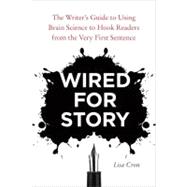
Note: Supplemental materials are not guaranteed with Rental or Used book purchases.
Purchase Benefits
What is included with this book?
| Introduction | p. 1 |
| How to Hook the Reader | p. 6 |
| Cognitive Secret: We think in story, which allows us to envision the future. | |
| Story Secret: From the very first sentence, the reader must want to know what happens next. | |
| How to Zero In on Your Point | p. 23 |
| Cognitive Secret: When the brain focuses its full attention on something, it filters out all unnecessary information. | |
| Story Secret: To hold the brain's attention, everything in a story must be there on a need-to-know basis. | |
| I'll Feel What He's Feeling | p. 44 |
| Cognitive Secret: Emotion determines the meaning of everything-if we're not feeling, we're not conscious. | |
| Story Secret: All story is emotion based-if we're not feeling, we're not reading. | |
| What Does Your Protagonist Really Want? | p. 65 |
| Cognitive Secret: Everything we do is goal directed, and our biggest goal is figuring out everyone else's agenda, the better to achieve our own. | |
| Story Secret: A protagonist without a clear goal has nothing to figure out and nowhere to go. | |
| Digging Up Your Protagonist's Inner Issue | p. 84 |
| Cognitive Secret: We see the world not as it is, but as we believe it to be. | |
| Story Secret: You must know precisely when, and why, your protagonist's worldview was knocked out of alignment. | |
| The Story Is in the Specifics | p. 103 |
| Cognitive Secret: We don't think in the abstract; we think in specific images. | |
| Story Secret: Anything conceptual, abstract, or general must be made tangible in the protagonist's specific struggle. | |
| Courting Conflict, the Agent of Change | p. 124 |
| Cognitive Secret: The brain is wired to stubbornly resist change, even good change. | |
| Story Secret: Story is about change, which results only from unavoidable conflict. | |
| Cause and Effect | p. 144 |
| Cognitive Secret: From birth, our brain's primary goal is to make causal connections-if this, then that. | |
| Story Secret: A story follows a cause-and-effect trajectory from start to finish. | |
| What Can Go Wrong, Must Go Wrong-and Then Some | p. 166 |
| Cognitive Secret: The brain uses stories to simulate how we might navigate difficult situations in the future. | |
| Story Secret: A story's job is to put the protagonist through tests that, even in her wildest dreams, she doesn't think she can pass. | |
| The Road from Setup to Payoff | p. 185 |
| Cognitive Secret: Since the brain abhors randomness, it's always converting raw data into meaningful patterns, the better to anticipate what might happen next. | |
| Story Secret: Readers are always on the lookout for patterns; to your reader, everything is either a setup, a payoff, or the road in between. | |
| Meanwhile, Back at the Ranch | p. 200 |
| Cognitive Secret: The brain summons past memories to evaluate what's happening in the moment in order to make sense of it. | |
| Story Secret: Foreshadowing, flashbacks, and subplots must instantly give readers insight into what's happening in the main storyline, even if the meaning shifts as the story unfolds. | |
| The Writer's Brain on Story | p. 219 |
| Cognitive Secret: It takes long-term, conscious effort to hone a skill before the brain assigns it to the cognitive unconscious. | |
| Story Secret: There's no writing; there's only rewriting. | |
| Endnotes | p. 239 |
| Acknowledgments | p. 251 |
| About the Author | p. 253 |
| Index | p. 254 |
| Table of Contents provided by Ingram. All Rights Reserved. |
The New copy of this book will include any supplemental materials advertised. Please check the title of the book to determine if it should include any access cards, study guides, lab manuals, CDs, etc.
The Used, Rental and eBook copies of this book are not guaranteed to include any supplemental materials. Typically, only the book itself is included. This is true even if the title states it includes any access cards, study guides, lab manuals, CDs, etc.